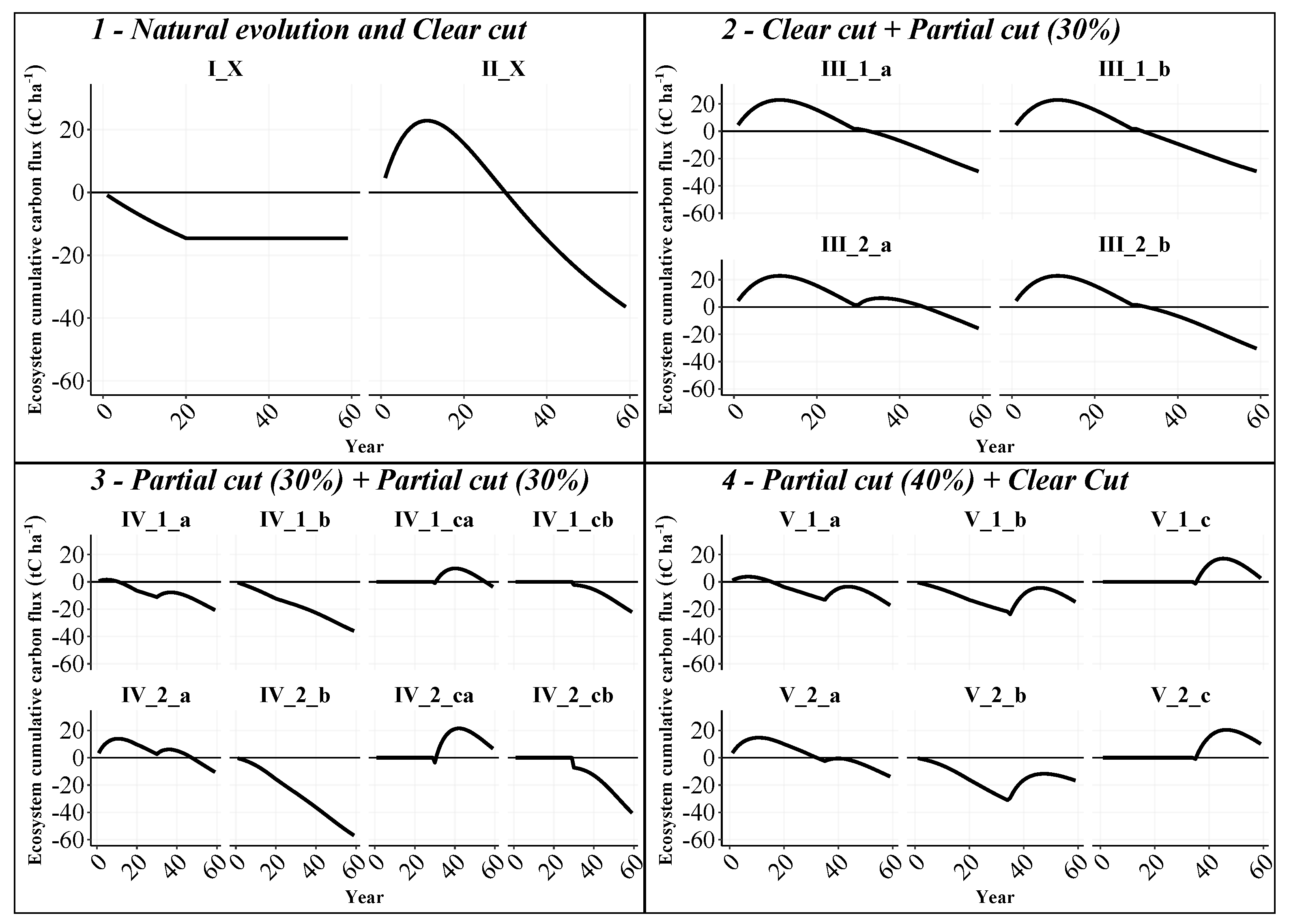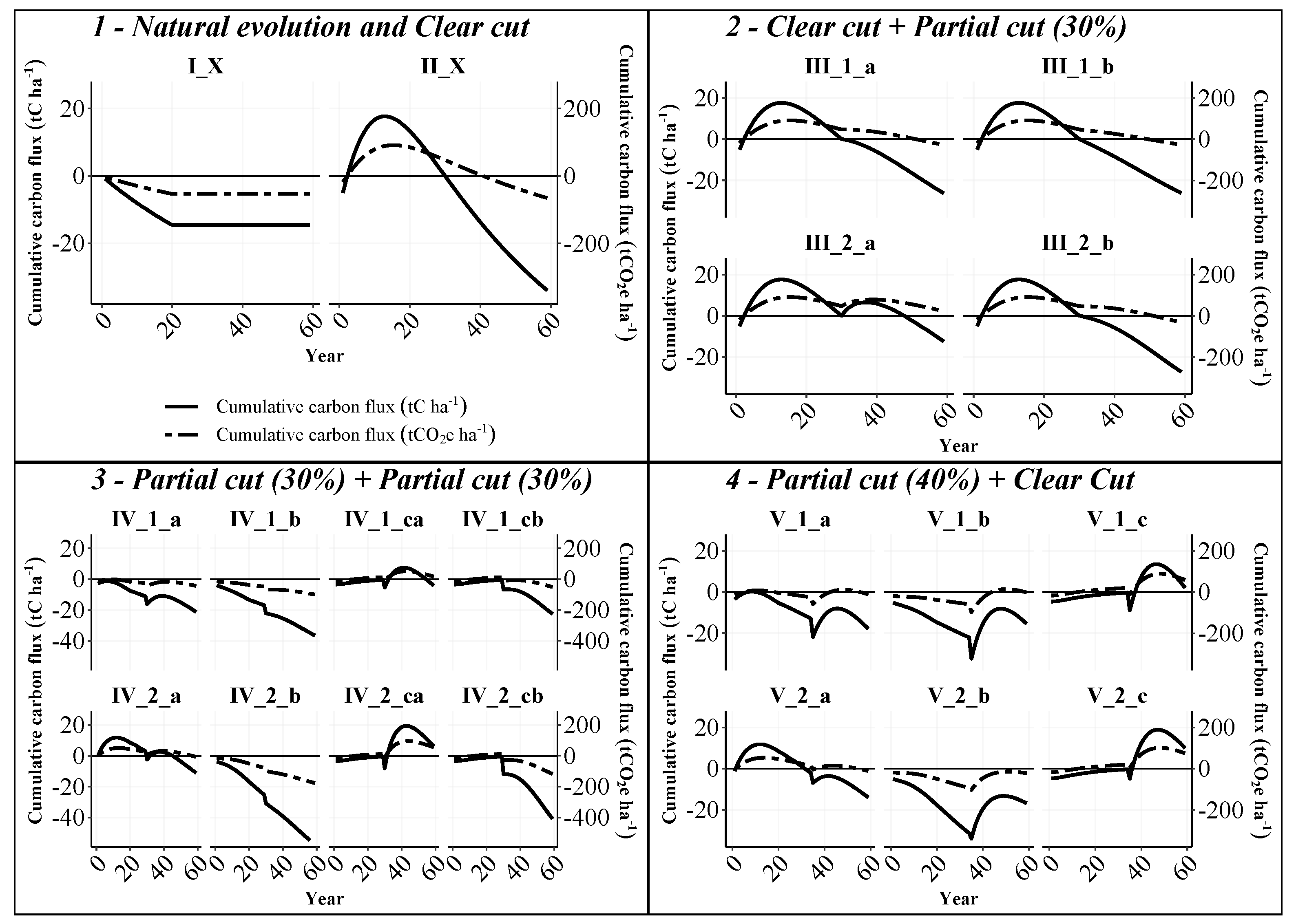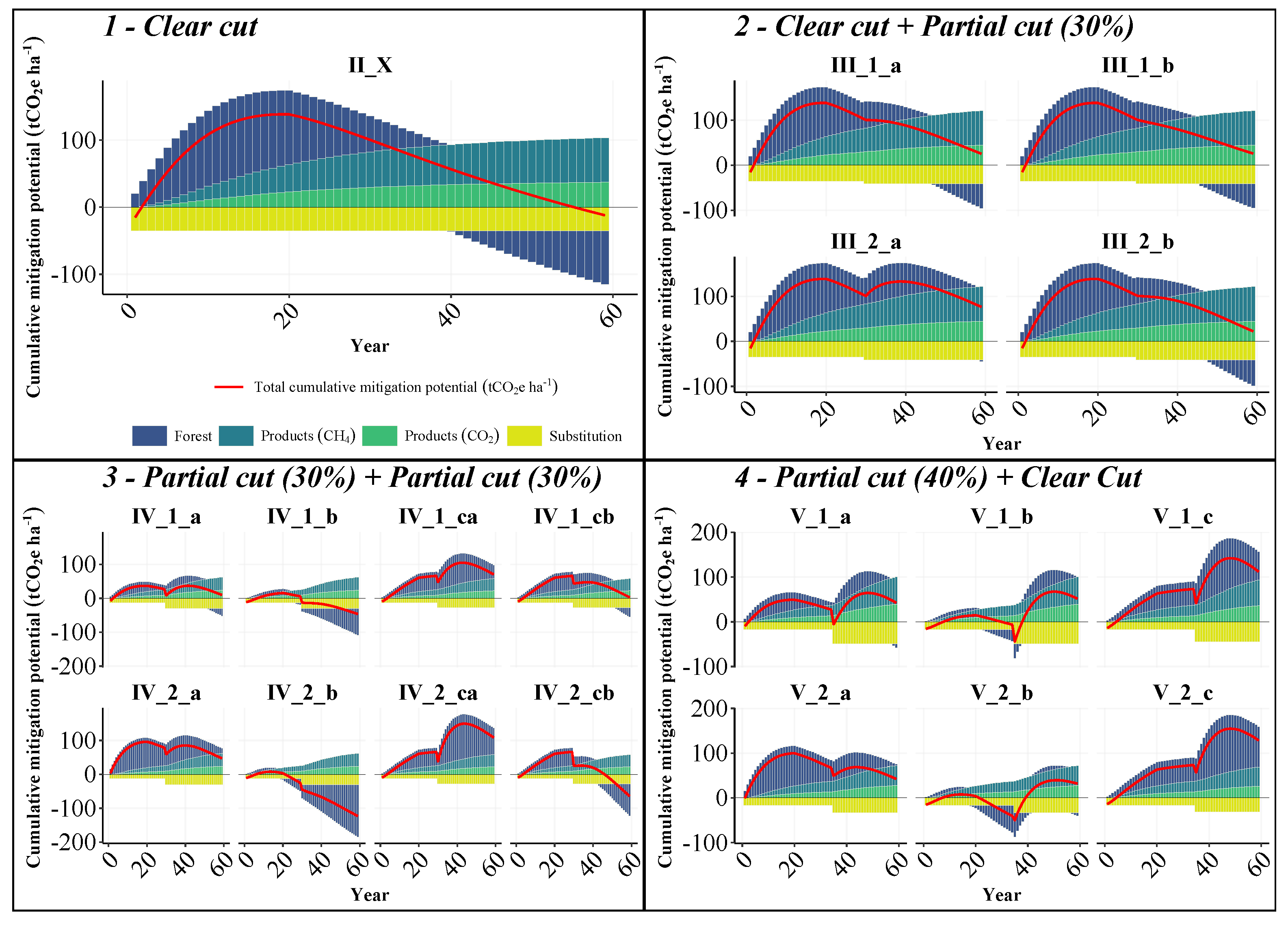Assessing the Effects of Different Harvesting Practices on the Forestry Sector’s Climate Benefits Potential: A Stand Level Theoretical Study in an Eastern Canadian Boreal Forest
Abstract
:1. Introduction
2. Materials and Methods
2.1. Case Study Area
2.2. Forest Management Framework
2.3. Wood Products Framework
2.4. Modelling
2.4.1. Forest Ecosystems
2.4.2. Wood Products and Substitution
2.5. Carbon Budget and Mitigation Potential
2.6. Radiative Forcing
3. Results
3.1. Carbon Budgets for Forest Ecosystems
3.2. Carbon Budgets for the Whole Forest Sector
3.2.1. Carbon Budgets in Tonnes of Carbon
3.2.2. Carbon Budgets in Tonnes of Carbon Dioxide Equivalent
3.3. Mitigation Potential
3.4. Breakdown of Carbon Fluxes
3.5. Mitigation Potential per Unit of Harvested Wood
3.6. Radiative Forcing
4. Discussion
5. Conclusions
Author Contributions
Funding
Data Availability Statement
Conflicts of Interest
Abbreviations
| C | Carbon |
| CH | Methane |
| CO | Carbon dioxide |
| COe | Carbon dioxide equivalent |
| DF | Displacement factor |
| DOM | Dead organic matter |
| GHG | Greenhouse Gas |
| GWP100 | Global Warming Potential over 100 years |
| HWP | Harvested wood products |
| IPCC | Intergovernmental Panel on Climate Change |
References
- Grassi, G.; House, J.; Dentener, F.; Federici, S.; den Elzen, M.; Penman, J. The key role of forests in meeting climate targets requires science for credible mitigation. Nat. Clim. Chang. 2017, 7, 220–226. [Google Scholar] [CrossRef]
- Nabuurs, G.J.; Andrasko, K.; Benitez-Ponce, P.; Boer, R.; Dutschke, M.; Elsiddig, E.; Ford-Robertson, J.; Matsumoto, M.; Oyhantcabal, W.; Achard, F.; et al. 2007: Forestry. In Climate Change 2007: Mitigation. Contribution of Working Group III to the Fourth Assessment Report of the Intergovernmental Panel on Climate Change; Metz, B., Davidson, O.R., Bosch, P.R., Dave, R., Meyer, L.A., Eds.; Cambridge University Press: Cambridge, UK; New York, NY, USA, 2007; p. 44. [Google Scholar]
- Nabuurs, G.J.; Hatab, A.A.; Bustamante, M.; Clark, H.; Havlík, P.; Ninan, K.N.; Popp, A.; Roe, S.; Aoki, L.; Angers, D.; et al. Agriculture, Forestry and Other Land Uses (AFOLU). In IPCC, 2022: Climate Change 2022: Mitigation of Climate Change. Contribution of Working Group III to the Sixth Assessment Report of the Intergovernmental Panel on Climate Change; Shukla, P.R., Skea, J., Slade, R., Khourdajie, A.A., Diemen, R.v., McCollum, D., Pathak, M., Some, S., Vyas, P., Fradera, R., et al., Eds.; Cambridge University Press: Cambridge, UK; New York, NY, USA, 2022. [Google Scholar]
- Bernier, P.; Astrup, R.; Bright, R.; Genet, H.; Hurmekoski, E.; Kraxner, F.; Liski, J.; Lundmark, T.; McGuire, D.; Moen, J.; et al. How Can the Circumboreal Forest Contribute to Mitigating Climate Change? Meeting Report; IBFRA: Haparanda, Sweden, 2018. [Google Scholar]
- Smyth, C.E.; Stinson, G.; Neilson, E.; Lemprière, T.C.; Hafer, M.; Rampley, G.J.; Kurz, W.A. Quantifying the biophysical climate change mitigation potential of Canada’s forest sector. Biogeosciences 2014, 11, 3515–3529. [Google Scholar] [CrossRef]
- Moreau, L.; Thiffault, E.; Cyr, D.; Boulanger, Y.; Beauregard, R. How can the forest sector mitigate climate change in a changing climate? Case studies of boreal and northern temperate forests in eastern Canada. For. Ecosyst. 2022, 9, 100026. [Google Scholar] [CrossRef]
- Peichl, M.; Martínez-García, E.; Fransson, J.E.S.; Wallerman, J.; Laudon, H.; Lundmark, T.; Nilsson, M.B. Landscape-variability of the carbon balance across managed boreal forests. Glob. Chang. Biol. 2023, 29, 1119–1132. [Google Scholar] [CrossRef] [PubMed]
- Kurz, W.; Shaw, C.; Boisvenue, C.; Stinson, G.; Metsaranta, J.; Leckie, D.; Dyk, A.; Smyth, C.; Neilson, E. Carbon in Canada’s boreal forest—A synthesis. Environ. Rev. 2013, 21, 260–292. [Google Scholar] [CrossRef]
- Senez-Gagnon, F.; Thiffault, E.; Paré, D.; Achim, A.; Bergeron, Y. Dynamics of detrital carbon pools following harvesting of a humid eastern Canadian balsam fir boreal forest. For. Ecol. Manag. 2018, 430, 33–42. [Google Scholar] [CrossRef]
- Paradis, L.; Thiffault, E.; Achim, A. Comparison of carbon balance and climate change mitigation potential of forest management strategies in the boreal forest of Quebec (Canada). Forestry 2019, 92, 264–277. [Google Scholar] [CrossRef]
- Ameray, A.; Bergeron, Y.; Valeria, O.; Montoro Girona, M.; Cavard, X. Forest Carbon Management: A Review of Silvicultural Practices and Management Strategies Across Boreal, Temperate and Tropical Forests. Curr. For. Rep. 2021, 7, 245–266. [Google Scholar] [CrossRef]
- Thorpe, H.C.; Thomas, S.C.; Caspersen, J.P. Residual-tree growth responses to partial stand harvest in the black spruce (Picea mariana) boreal forest. Can. J. For. Res. 2007, 37, 1563–1571. [Google Scholar] [CrossRef]
- Gauthier, M.M.; Barrette, M.; Tremblay, S. Commercial Thinning to Meet Wood Production Objectives and Develop Structural Heterogeneity: A Case Study in the Spruce-Fir Forest, Quebec, Canada. Forests 2015, 6, 510–532. [Google Scholar] [CrossRef]
- Bose, A.K.; Weiskittel, A.; Kuehne, C.; Wagner, R.G.; Turnblom, E.; Burkhart, H.E. Tree-level growth and survival following commercial thinning of four major softwood species in North America. For. Ecol. Manag. 2018, 427, 355–364. [Google Scholar] [CrossRef]
- Pukkala, T. Does biofuel harvesting and continuous cover management increase carbon sequestration? For. Policy Econ. 2014, 43, 41–50. [Google Scholar] [CrossRef]
- Montoro Girona, M.; Morin, H.; Lussier, J.M.; Ruel, J.C. Post-cutting Mortality Following Experimental Silvicultural Treatments in Unmanaged Boreal Forest Stands. Front. For. Glob. Chang. 2019, 2, 4. [Google Scholar] [CrossRef]
- Ruel, J.C.; Gardiner, B. Mortality patterns after different levels of harvesting of old-growth boreal forests. For. Ecol. Manag. 2019, 448, 346–354. [Google Scholar] [CrossRef]
- Moussaoui, L.; Leduc, A.; Girona, M.M.; Bélisle, A.C.; Lafleur, B.; Fenton, N.J.; Bergeron, Y. Success Factors for Experimental Partial Harvesting in Unmanaged Boreal Forest: 10-Year Stand Yield Results. Forests 2020, 11, 1199. [Google Scholar] [CrossRef]
- Xie, S.H.; Kurz, W.A.; McFarlane, P.N. Inward- versus outward-focused bioeconomy strategies for British Columbia’s forest products industry: A harvested wood products carbon storage and emission perspective. Carbon Balance Manag. 2021, 16, 30. [Google Scholar] [CrossRef] [PubMed]
- MELCCFP; MAPAQ. GES 1990–2020. Méthodologie de Calcul D’émissions, Description des Secteurs et Facteurs D’émission. Annexes à L’inventaire Québécois des Émissions de Gaz à Effet de Serre en 2020 et Leur Évolution Depuis 1990; Annexes Techniques; Direction des Communications du MELCCFP: Québec City, QC, Canada, 2022.
- Forster, P.; Ramaswamy, V.; Artaxo, P.; Berntsen, T.; Betts, R.; Fahey, D.W.; Haywood, J.; Lean, J.; Lowe, D.C.; Raga, G.; et al. 2007: Changes in Atmospheric Constituents and in Radiative Forcing. In Climate Change 2007: The Physical Science Basis. Contribution of Working Group I to the Fourth Assessment Report of the Intergovernmental Panel on Climate Change; Solomon, S., Qin, D., Manning, M., Chen, Z., Marquis, M., Averyt, K.B., Tignor, M., Miller, H.L., Eds.; Cambridge University Press: Cambridge, UK; New York, NY, USA, 2007; p. 106. [Google Scholar]
- Leskinen, P.; Cardellini, G.; González-García, S.; Hurmekoski, E.; Sathre, R.; Seppälä, J.; Smyth, C.; Stern, T.; Verkerk, P.J.; European Forest Institute. Substitution Effects of Wood-Based Products in Climate Change Mitigation; From Science to Policy; European Forest Institute: Joensuu, Finland, 2018. [Google Scholar] [CrossRef]
- Seppälä, J.; Heinonen, T.; Pukkala, T.; Kilpeläinen, A.; Mattila, T.; Myllyviita, T.; Asikainen, A.; Peltola, H. Effect of increased wood harvesting and utilization on required greenhouse gas displacement factors of wood-based products and fuels. J. Environ. Manag. 2019, 247, 580–587. [Google Scholar] [CrossRef]
- Hurmekoski, E.; Smyth, C.E.; Stern, T.; Verkerk, P.J.; Asada, R. Substitution impacts of wood use at the market level: A systematic review. Environ. Res. Lett. 2021, 16, 123004. [Google Scholar] [CrossRef]
- Harmon, M.E. Have product substitution carbon benefits been overestimated? A sensitivity analysis of key assumptions. Environ. Res. Lett. 2019, 14, 065008. [Google Scholar] [CrossRef]
- Howard, C.; Dymond, C.C.; Griess, V.C.; Tolkien-Spurr, D.; van Kooten, G.C. Wood product carbon substitution benefits: A critical review of assumptions. Carbon Balance Manag. 2021, 16, 9. [Google Scholar] [CrossRef]
- Xu, Z.; Smyth, C.E.; Lemprière, T.C.; Rampley, G.J.; Kurz, W.A. Climate change mitigation strategies in the forest sector: Biophysical impacts and economic implications in British Columbia, Canada. Mitig. Adapt. Strateg. Glob. Chang. 2018, 23, 257–290. [Google Scholar] [CrossRef] [PubMed]
- Levasseur, A.; Lesage, P.; Margni, M.; Deschênes, L.; Samson, R. Considering Time in LCA: Dynamic LCA and Its Application to Global Warming Impact Assessments. Environ. Sci. Technol. 2010, 44, 3169–3174. [Google Scholar] [CrossRef]
- Brandão, M.; Levasseur, A.; Kirschbaum, M.U.F.; Weidema, B.P.; Cowie, A.L.; Jørgensen, S.V.; Hauschild, M.Z.; Pennington, D.W.; Chomkhamsri, K. Key issues and options in accounting for carbon sequestration and temporary storage in life cycle assessment and carbon footprinting. Int. J. Life Cycle Assess. 2013, 18, 230–240. [Google Scholar] [CrossRef]
- Breton, C.; Blanchet, P.; Amor, B.; Beauregard, R.; Chang, W.S. Assessing the Climate Change Impacts of Biogenic Carbon in Buildings: A Critical Review of Two Main Dynamic Approaches. Sustainability 2018, 10, 2020. [Google Scholar] [CrossRef]
- Saucier, J.P.; Bergeron, J.F.; Grondin, P.; Robitaille, A. Les régions écologiques du Québec méridional: Un des éléments du système hiérarchique de classification écologique du territoire mis au point par le Ministère des Ressources Naturelles. MNRQ 1998, 1, 1–12. [Google Scholar]
- Bureau de Mise en Marché des Bois. Guide D’analyse économique Appliquée aux Investissements Sylvicoles; Bureau de Mise en Marché des Bois: Québec City, QC, Canada, 2018; Volume 1.
- Kurz, W.A.; Dymond, C.C.; White, T.M.; Stinson, G.; Shaw, C.H.; Rampley, G.J.; Smyth, C.; Simpson, B.N.; Neilson, E.T.; Trofymow, J.A.; et al. CBM-CFS3: A model of carbon-dynamics in forestry and land-use change implementing IPCC standards. Ecol. Model. 2009, 220, 480–504. [Google Scholar] [CrossRef]
- Harel, A.; Thiffault, E.; Paré, D. Ageing forests and carbon storage: A case study in boreal balsam fir stands. Forestry 2021, 94, 651–663. [Google Scholar] [CrossRef]
- IPCC. 2013 Revised Supplementary Methods and Good Practice Guidance Arising from the Kyoto Protocol; Technical Report; IPCC: Interlaken, Switzerland, 2014. [Google Scholar]
- IPCC. IPCC Guidelines for National Greenhouse Gas Inventory; Technical Report; IPCC: Kyoto, Japan, 2006. [Google Scholar]
- Rüter, S.; Matthews, R.; Lundblad, M.; Sato, A.; Hassan, R. Volume 4, Chapter 12: Harvested Wood products. In 2019 Refinement to the 2006 IPCC Guidelines for National Greenhouse Gas Inventories; Technical Report; IPCC: Interlaken, Switzerland, 2019. [Google Scholar]
- Sathre, R.; O’Connor, J. Meta-analysis of greenhouse gas displacement factors of wood product substitution. Environ. Sci. Policy 2010, 13, 104–114. [Google Scholar] [CrossRef]
- Beauregard, R.; Lavoie, P.; Thiffault, E.; Ménard, I.; Moreau, L.; Boucher, J.F.; Robichaud, F. Rapport du Groupe de Travail sur la Foret et les Changements Climatiques; Technical Report; GTFCC: Quebec, QC, Canada, 2019. [Google Scholar]
- Gao, B.; Taylor, A.R.; Searle, E.B.; Kumar, P.; Ma, Z.; Hume, A.M.; Chen, H.Y.H. Carbon Storage Declines in Old Boreal Forests Irrespective of Succession Pathway. Ecosystems 2018, 21, 1168–1182. [Google Scholar] [CrossRef]
- Smyth, C.E.; Xu, Z.; Lemprière, T.C.; Kurz, W.A. Climate change mitigation in British Columbia’s forest sector: GHG reductions, costs, and environmental impacts. Carbon Balance Manag. 2020, 15, 21. [Google Scholar] [CrossRef]
- Gundersen, P.; Thybring, E.E.; Nord-Larsen, T.; Vesterdal, L.; Nadelhoffer, K.J.; Johannsen, V.K. Old-growth forest carbon sinks overestimated. Nature 2021, 591, E21–E23. [Google Scholar] [CrossRef] [PubMed]
- Sharma, T.; Kurz, W.A.; Stinson, G.; Pellatt, M.G.; Li, Q. A 100-year conservation experiment: Impacts on forest carbon stocks and fluxes. For. Ecol. Manag. 2013, 310, 242–255. [Google Scholar] [CrossRef]
- Houndode, D.J.; Krause, C.; Morin, H. Predicting balsam fir mortality in boreal stands affected by spruce budworm. For. Ecol. Manag. 2021, 496, 119408. [Google Scholar] [CrossRef]
- Kallio, A.M.I.; Solberg, B. Leakage of forest harvest changes in a small open economy: Case Norway. Scand. J. For. Res. 2018, 33, 502–510. [Google Scholar] [CrossRef]
- Nepal, P.; Ince, P.J.; Skog, K.E.; Chang, S.J. Forest carbon benefits, costs and leakage effects of carbon reserve scenarios in the United States. J. For. Econ. 2013, 19, 286–306. [Google Scholar] [CrossRef]
- Hu, X.; Shi, G.; Hodges, D.G. International Market Leakage from China’s Forestry Policies. Forests 2014, 5, 2613–2625. [Google Scholar] [CrossRef]
- FAO. Forest Products in the Global Bioeconomy Enabling Substitution by Wood-Based Products and Contributing to the Sustainable Development Goals; Technical Report; FAO: Roma, Italy, 2022. [Google Scholar] [CrossRef]
- Hassegawa, M.; Karlberg, A.; Hertzberg, M.; Verkerk, P. Innovative forest products in the circular bioeconomy. Open Res. Eur. 2022, 2, 19. [Google Scholar] [CrossRef]
- Hurmekoski, E.; Kunttu, J.; Heinonen, T.; Pukkala, T.; Peltola, H. Does expanding wood use in construction and textile markets contribute to climate change mitigation? Renew. Sustain. Energy Rev. 2023, 174, 113152. [Google Scholar] [CrossRef]
- Smith, P.; Bustamante, M.; Ahammad, H.; Clark, H.; Dong, H.; Elsiddig, E.; Haberl, H.; Harper, R.; House, J.; Jafari, M.; et al. Climate Change 2014 Mitigation of Climate Change: Working Group III Contribution to the Fifth Assessment Techreport of the Intergovernmental Panel on Climate Change; Technical Report; Cambridge University Press: Cambridge, UK, 2014. [Google Scholar] [CrossRef]
- Chen, J.; Ter-Mikaelian, M.T.; Ng, P.Q.; Colombo, S.J. Ontario’s managed forests and harvested wood products contribute to greenhouse gas mitigation from 2020 to 2100. For. Chron. 2018, 94, 269–282. [Google Scholar]
- Chen, J.; Ter-Mikaelian, M.T.; Yang, H.; Colombo, S.J. Assessing the greenhouse gas effects of harvested wood products manufactured from managed forests in Canada. Forestry 2018, 91, 193–205. [Google Scholar] [CrossRef]
- Hurmekoski, E.; Jonsson, R.; Korhonen, J.; Jänis, J.; Mäkinen, M.; Leskinen, P.; Hetemäki, L. Diversification of the forest industries: Role of new wood-based products. Can. J. For. Res. 2018, 48, 1417–1432. [Google Scholar] [CrossRef]
- Montoro Girona, M.; Morin, H.; Lussier, J.M.; Walsh, D. Radial Growth Response of Black Spruce Stands Ten Years after Experimental Shelterwoods and Seed-Tree Cuttings in Boreal Forest. Forests 2016, 7, 240. [Google Scholar] [CrossRef]
- Montoro Girona, M.; Rossi, S.; Lussier, J.M.; Walsh, D.; Morin, H. Understanding tree growth responses after partial cuttings: A new approach. PLoS ONE 2017, 12, e0172653. [Google Scholar] [CrossRef]
- Boivin-Dompierre, S.; Achim, A.; Pothier, D. Functional response of coniferous trees and stands to commercial thinning in eastern Canada. For. Ecol. Manag. 2017, 384, 6–16. [Google Scholar] [CrossRef]
- Moreau, G.; Achim, A.; Pothier, D. Growth and survival dynamics of partially cut northern hardwood stands as affected by precut competition and spatial distribution of residual trees. Forestry 2020, 93, 96–106. [Google Scholar] [CrossRef]
- Chen, J.; Colombo, S.J.; Ter-Mikaelian, M.T.; Heath, L.S. Carbon Profile of the Managed Forest Sector in Canada in the 20th Century: Sink or Source? Environ. Sci. Technol. 2014, 48, 9859–9866. [Google Scholar] [CrossRef]
- Smyth, C.; Rampley, G.; Lemprière, T.C.; Schwab, O.; Kurz, W.A. Estimating product and energy substitution benefits in national-scale mitigation analyses for Canada. GCB Bioenergy 2017, 9, 1071–1084. [Google Scholar] [CrossRef]
- Kalliokoski, T.; Bäck, J.; Boy, M.; Kulmala, M.; Kuusinen, N.; Mäkelä, A.; Minkkinen, K.; Minunno, F.; Paasonen, P.; Peltoniemi, M.; et al. Mitigation Impact of Different Harvest Scenarios of Finnish Forests That Account for Albedo, Aerosols, and Trade-Offs of Carbon Sequestration and Avoided Emissions. Front. For. Glob. Chang. 2020, 3, 562044. [Google Scholar] [CrossRef]
- Kellomäki, S.; Väisänen, H.; Kirschbaum, M.U.F.; Kirsikka-Aho, S.; Peltola, H. Effects of different management options of Norway spruce on radiative forcing through changes in carbon stocks and albedo. Forestry 2021, 94, 588–597. [Google Scholar] [CrossRef]
- Gouvernement du Québec. Chapter Q-2, r.19 Regulation Respecting the Landfilling and Incineration of Residual Materials—Environment Quality Act. Quebec; Gouvernement du Québec: Quebec, QC, Canada, 2021.
- Environment and Climate Change Canada. Federal Offset Protocol: Landfill Methane Recovery and Destruction. Version 1 Junne 2022; Offset Protocol; Environment and Climate Change Canada: Ottawa, ON, Canada, 2022.







Disclaimer/Publisher’s Note: The statements, opinions and data contained in all publications are solely those of the individual author(s) and contributor(s) and not of MDPI and/or the editor(s). MDPI and/or the editor(s) disclaim responsibility for any injury to people or property resulting from any ideas, methods, instructions or products referred to in the content. |
© 2023 by the authors. Licensee MDPI, Basel, Switzerland. This article is an open access article distributed under the terms and conditions of the Creative Commons Attribution (CC BY) license (https://creativecommons.org/licenses/by/4.0/).
Share and Cite
Moreau, L.; Thiffault, E.; Beauregard, R. Assessing the Effects of Different Harvesting Practices on the Forestry Sector’s Climate Benefits Potential: A Stand Level Theoretical Study in an Eastern Canadian Boreal Forest. Forests 2023, 14, 1109. https://doi.org/10.3390/f14061109
Moreau L, Thiffault E, Beauregard R. Assessing the Effects of Different Harvesting Practices on the Forestry Sector’s Climate Benefits Potential: A Stand Level Theoretical Study in an Eastern Canadian Boreal Forest. Forests. 2023; 14(6):1109. https://doi.org/10.3390/f14061109
Chicago/Turabian StyleMoreau, Lucas, Evelyne Thiffault, and Robert Beauregard. 2023. "Assessing the Effects of Different Harvesting Practices on the Forestry Sector’s Climate Benefits Potential: A Stand Level Theoretical Study in an Eastern Canadian Boreal Forest" Forests 14, no. 6: 1109. https://doi.org/10.3390/f14061109






